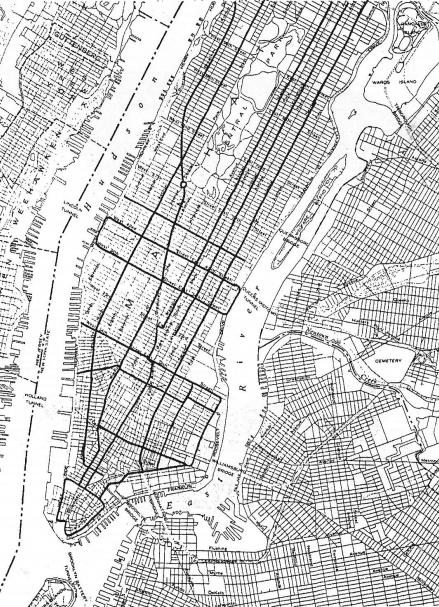Under orders from Gov. Cuomo, Mayor de Blasio banned cars on four short stretches of city streets so that residents and visitors could have the space they need to move around in a dense metropolis without fear of spreading the dreaded COVID-19 virus.
The resulting several-block “quarantine” may be a reasonable short-term strategy to deal with a medical emergency, but a much more comprehensive effort is needed.
As the virus has underscored, dense cities such as ours require a more equitable allocation of street space in order to thrive in the long term. Closing streets to traffic and enhancing amenities in the crowded core will be vital to the survival of urban life in America. A coherent street-use plan should be developed now, so that it can be put in place once the virus is contained.
Auto-Free New York, a project of the Institute for Rational Mobility, prepared just such a comprehensive street plan some 30 years ago. Our vision was for a grid of some 60 miles of auto-free streets in the core of Manhattan (see illustration below). In 1999, going a step beyond a proposal by civic activist Fred Papert, we formed vision42, a citizen’s group that advocates for river-to-river light-rail boulevard on 42nd Street. Both proposals attracted support, but lobbyists for motorists defeated the efforts.
In this time of crisis, we urge the mayor and other city officials to reconsider our street plan and the vision42 proposal.

Making streets auto-free in the manner we advocate was always a good public health idea, given that pedestrians have traditionally outnumbered vehicles on city streets by six to one. The trend of pedestrianization has been embraced around the world: Many cities in Europe, and a half-dozen cities in America, have light-rail pedestrian streets, and other streets completely closed to motor vehicles, which free space to become available for what eventually could be a richly landscaped green space in the urban core.
With congestion pricing coming next year (hopefully!) to Manhattan’s Central Business District, potentially lightening the volume of traffic, now is the time to bring such a comprehensive plan to the crowded streets of Midtown. Auto Free New York argued for the proposal in a statement last March supporting the congestion-pricing plan.

Unfortunately, New York City often doesn't plan well or comprehensively; successive initiatives over the decades that sought to free urban space from cars have amounted to a “mockery of ad hockery” — piecemeal efforts that have taken off, only to be dashed with the next administration.
Look at the history: Mayor Lindsay’s car-free initiatives for the boroughs, the Fulton Mall in Brooklyn and the 165th Street Mall in Jamaica, survive, but his effort to close the loop drives in Central Park to cars was finally achieved in 2018, after a half-century of advocacy.
Mayor Dinkins championed light rail on 42nd Street — initiating an environmental-impact analysis and closing the street to great acclaim on Earth Day in 1990, 1991 and 1992. But the effort died with his mayoralty.
Mayor Bloomberg (who dismissed light rail on 42nd Street in favor of extending the No. 7 subway line) moved aggressively to advance a series of pedestrian plazas along Broadway; his successor, Mayor de Blasio, has not advanced those efforts despite many calls to do so.
Finally, de Blasio has ignored repeated requests from Auto-Free New York that he close 42nd Street to traffic in the same way that he closed 14th Street, where the busway has been so successful.
De Blasio, for his part, has advocated a Brooklyn-Queens light-rail line, the BQX, which would encourage development along the east bank of the East River, now clearly needed as the city faces the economic fall-off of the pandemic. With the construction of light rail costing only one-tenth as much per mile as the building of subways, the city should embrace the potential of such an investment in Midtown.
Auto-Free New York stands ready to assist.
George Haikalis heads Auto-Free New York and is the president of the Institute for Rational Urban Mobility, Inc. Roxanne Warren is chair of vision42.






